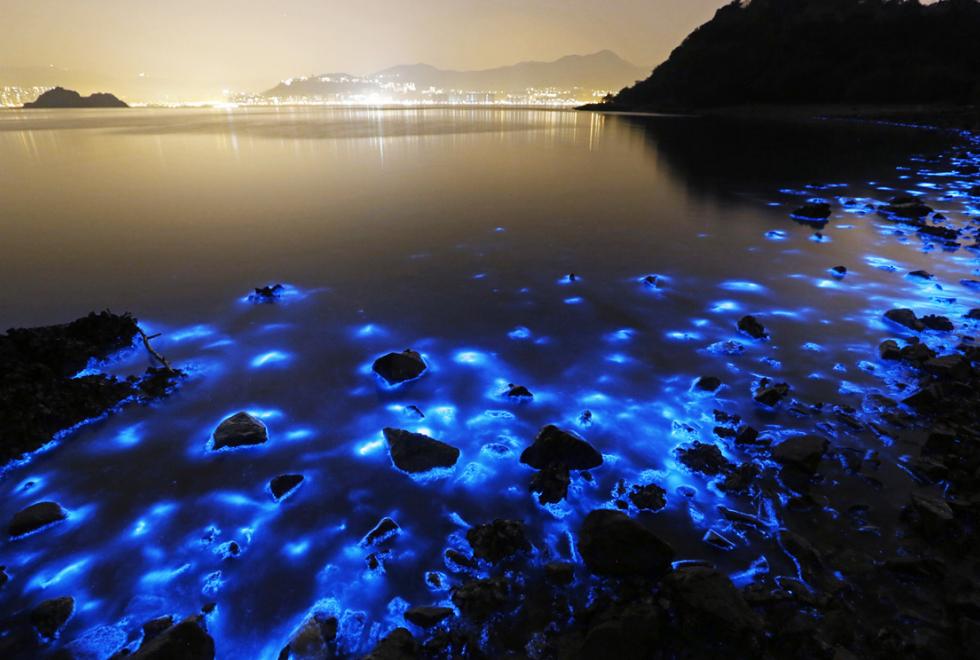The Glowing Waters of the Arabian Sea are Killing off Ocean Life
“The
fish are migrating. They can’t get enough air here.” — Saleh
al-Mashari, captain
of a researcher vessel in the Gulf of Oman
*****
Roberrtsctibbler,
19
March, 2017
They
are an ancient, primordial race of tiny organisms called noctiluca
scintillans.
And for millenia they have lived undisturbed in the deep waters
between Oman and India. But as human fossil fuel burning forced the
world to warm, this 1.2 billion year old species was dredged up from
the deep.
Growing
atmospheric and ocean heat fed the great storms that make up India’s
southern monsoon. And as these storms intensified, they churned the
waters of the Gulf of Oman, drawing
the ancient noctiluca scintillans up from below.
As these dinoflaggelates reached the surface they encountered more
food in the form of plankton even as they gained access to more
sunlight. Meanwhile, the strengthening monsoons seeded surface waters
with nutrients flushed down rivers and streams and into the ocean.
هكذا بعض بدت شواطئ هونج كونج يوم الخميس الماضي مليئة بطحالب مضيئة باللون الأزرق البراق في مشهد خلاب و نادر الحدوث
-
(Noctiluca blooms have become a common feature of the Gulf of Oman and the Arabian Sea. They have also recently appeared off New Zealand, Tasmania, and Hong Kong. Such blooms are a result of warmer waters, more intense storms, related increasing rates of soil nutrients flushing into the oceans due to more intense rainfall events, and other conditions consistent with human-caused climate change. Image source: FaHaD.)
In
this newly favorable environment, noctiluca subsequently bloomed.
Covering the ocean in a green mat by day and an oddly iridescent blue
when disturbed by the waves at night.
Phytoplankton
are the base of the marine food chain and noctiluca has
been voraciously devouring this key nutrient source over a
Mexico-sized stretch of ocean water during recent years.
As the noctiluca blooms expanded, they emitted toxins and an ammonia
smell that some in the region are calling sea
stench.
And as the great mats died and decayed, they have robbed the
surrounding waters of oxygen.
As
a result, mass fish kills have been reported and much of the local
sea life has fled the region.
March
2, 2017, image from the NASA MODIS satellite, shows a mass of
noctiluca scintillans blooms in the Arabian Sea off the coast of
Oman extending past Pakistan to India. (Image source: NASA and
USGS, via
AP)
Earth’s
environment usually changes slowly, over the course of thousands or
tens of thousands of years. In the past, this has given life a chance
to adjust. But the human-caused climate change that is spurring the
massive noctiluca blooms in the Arabian Sea is bringing on these new
conditions over the mere course of a few decades. Thirty years ago,
there was no visible trace of noctiluca in the waters of the Gulf of
Oman and Arabian Sea. Now, they have come to dominate.
The
oceans beneath the noctiluca mats are now increasingly robbed of
life. Oxygen levels are plummeting. The fish can’t breathe
there.
Links:
Hat
tip to Andy in San Diego
Hat
tip to Mulga













No comments:
Post a Comment
Note: only a member of this blog may post a comment.